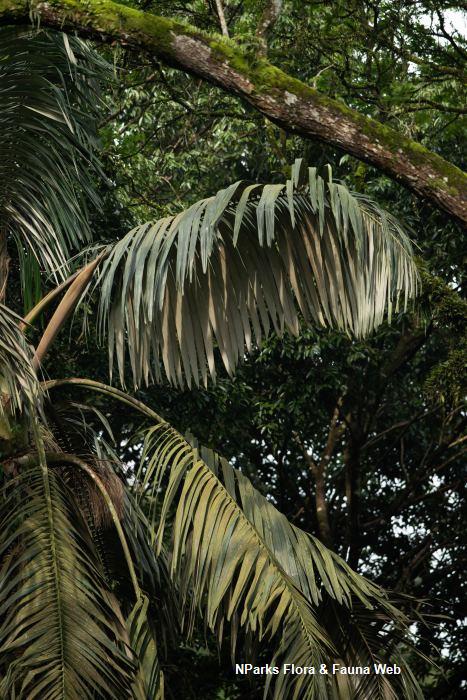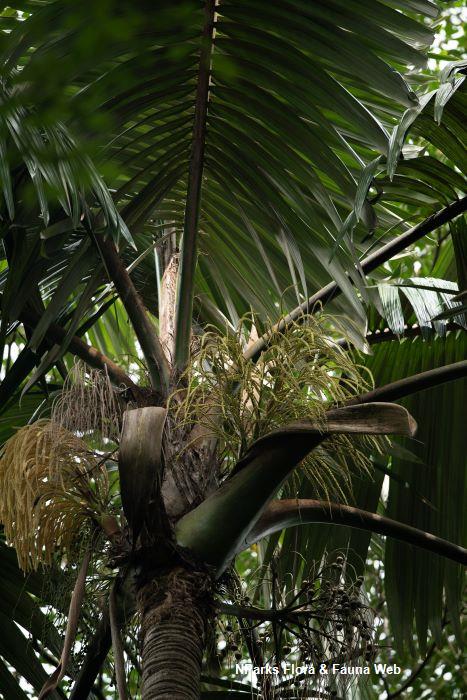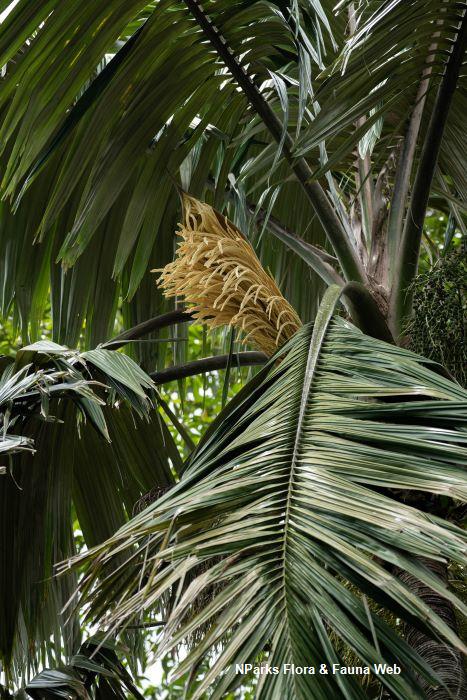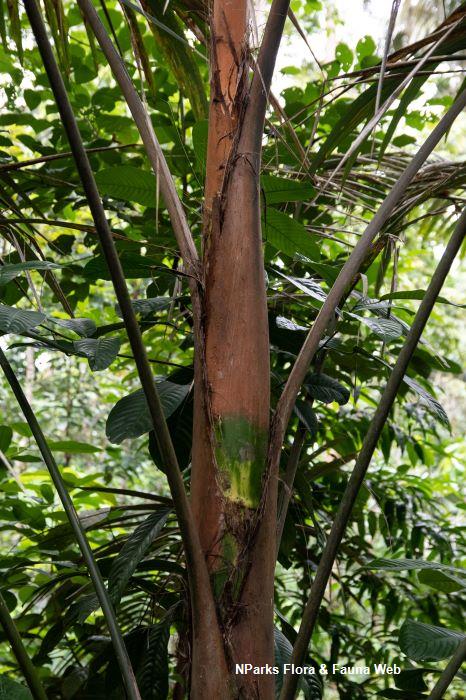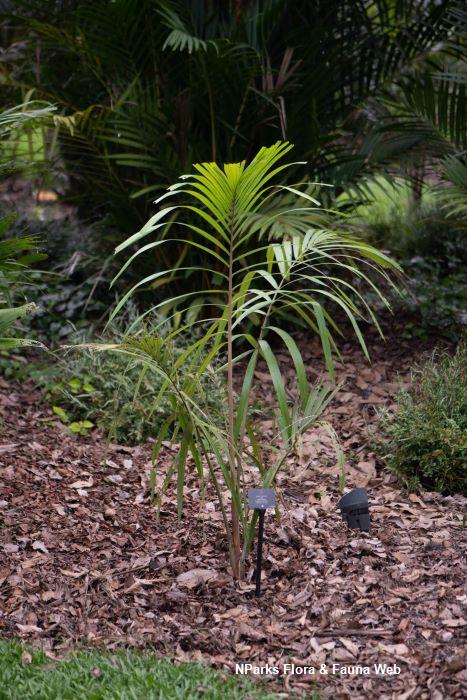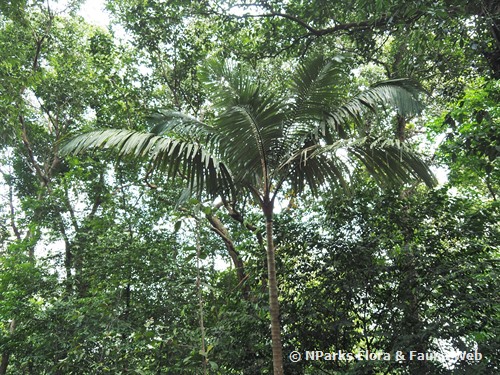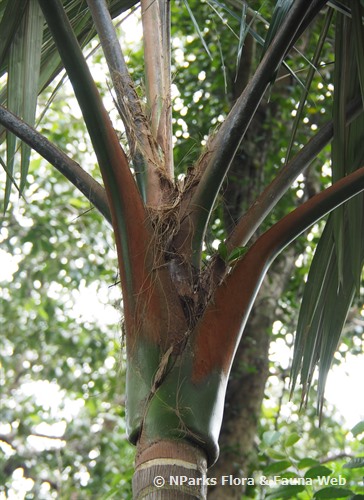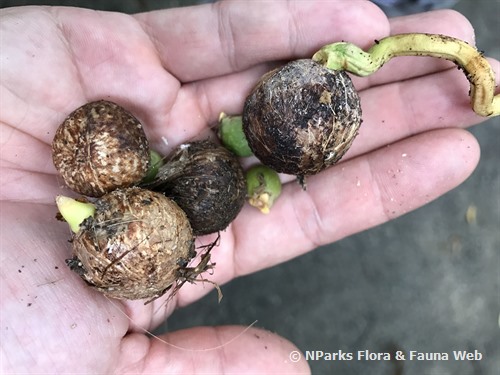
Back
Orania sylvicola (Griff.) H.E.Moore
| Family Name: | Arecaceae (Palmae) |
| Synonyms: | Macrocladus sylvicola Griff., Orania macrocladus Mart. |
| Common Name: | Ibul |
Name
Classifications and Characteristics
| Plant Division | Angiosperms (Flowering Seed Plants) (Monocotyledon) |
|---|---|
| Plant Growth Form | Palm (Solitary Habit) |
| Lifespan (in Singapore) | Perennial |
| Mode of Nutrition | Autotrophic |
| Maximum Height | 20 m |
Biogeography
| Native Distribution | Southern Thailand to Peninsular Malaysia, Singapore, and Sumatra |
|---|---|
| Native Habitat | Terrestrial |
| Preferred Climate Zone | Tropical |
| Local Conservation Status | Native to Singapore (Critically Endangered (CR)) |
Description and Ethnobotany
| Growth Form | It is a single-trunked, canopy to emergent palm, up to 20 m tall, with a trunk girth of up to 45 cm. The trunk is grey with rings and knobs. Its medium- to large-sized pinnate leaves spread spirally, rising or drooping from the tip of the trunk. |
|---|---|
| Foliage | Its spirally arranged, stalked, medium- to large-sized leaves are pinnate, with 60 – 75 leaflets arranged regularly on each side of the rachis, and 3.6 by 1.5 m. The leaflets are narrowly drop-shaped, with jagged tips, green above, greyish below, and 75–100 by 5–8 cm. |
| Flowers | Its small flowers are borne on a 3–5-branched, spreading inflorescence, 75–90 cm long. The inflorescences are usually borne amongst the leaves. The male flowers are oblong, while the female flowers are roundish. |
| Fruit | Its greenish yellow to yellow fruits are round and 3.5–4 cm. |
| Habitat | It grows in wet lowland forests, often in wet areas. It occurs locally in the Bukit Timah Nature Reserve and in the vicinity of MacRitchie Reservoir. |
| Cultivation | It is propagated by seed. |
| Etymology | The genus Orania is named in hounour of F.G.L. Willem van Nassau, the Prince of Orange (Oranje) and the Crown Prince of the Netherlands (1792–1849). The specific epithet sylvicola is derived from the Latin meaning "forest dwelling", referring to the habitat this species thrives in. |
Landscaping Features
| Landscaping | This plant is suitable for planting in moist, partially-shaded or open areas for its attractive, pinnate foliage. |
|---|---|
| Desirable Plant Features | Ornamental Foliage |
| Landscape Uses | Parks & Gardens |
Plant Care and Propagation
| Light Preference | Full Sun, Semi-Shade |
|---|---|
| Water Preference | Lots of Water, Moderate Water |
| Plant Growth Rate | Fast |
| Rootzone Tolerance | Moist Soils, Fertile Loamy Soils |
| Pest(s) | Chewing Insects |
Foliar
| Foliage Retention | Evergreen |
|---|---|
| Mature Foliage Colour(s) | Green |
| Foliar Type | Compound (Even-Pinnate) |
| Foliar Arrangement Along Stem | Spiral |
| Foliar Attachment to Stem | Petiolate |
| Foliar Shape(s) | Palm Fronds (Pinnate / Feather) |
| Leaf Area Index (LAI) for Green Plot Ratio | 2.5 (Palm - Solitary) |
Non - Foliar and Storage
| Trunk Type (Palm) | Aboveground, Solitary Habit |
|---|---|
| Root Type | Underground (Fibrous Root) |
Floral (Angiosperm)
| Flower & Plant Sexuality | Unisexual Flowers , Monoecious |
| Flower Colour(s) | Yellow / Golden |
|---|
| Flower Grouping | Cluster / Inflorescence |
| Flower Location | Axillary |
| Inflorescence Type | Panicle |
| Flowering Habit | Polycarpic |
Fruit, Seed and Spore
| Mature Fruit Colour(s) | Green, Yellow / Golden |
|---|---|
| Fruit Classification | Simple Fruit |
| Fruit Type | Fleshy Fruit , Drupe |
| Seed Quantity Per Fruit | Few (1-5) |
References
| References | Dransfield, J., Uhi, N.W., Asmussen, C.B., Baker, W.J., Harley, M.M. & Lewis, C.E. . 2008. Genera Palmarum. The Evolution and Classification of Palms. . United Kingdom: Kew Publishing. 732 |
|---|
Image Repository
Others
| Master ID | 1949 |
|---|---|
| Species ID | 3241 |
| Flora Disclaimer | The information in this website has been compiled from reliable sources, such as reference works on medicinal plants. It is not a substitute for medical advice or treatment and NParks does not purport to provide any medical advice. Readers should always consult his/her physician before using or consuming a plant for medicinal purposes. |

